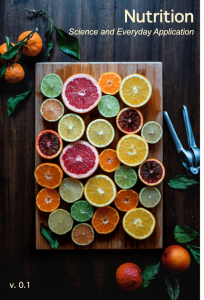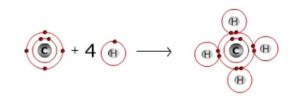Nutrition: Science and Everyday Application
Sui Ling Gilbert

Callahan, A., Leonard, H., & Powell, T. (2020) Nutrition: Science and Everyday Application. Pressbooks. https://openoregon.pressbooks.pub/nutritionscience/
Reviewed by: Sui, Lehman College
Introduction
This evaluation is on Nutrition: Science and Everyday Application by Alice Callahan, Heather Leonard, and Tamberly Powell. This textbook was created to be used as an educational resource by students taking a course at Lane Community College in Eugene, Oregon. It covers basic nutrition topics, which is appropriate as the course was written for students planning to go into healthcare. There are eleven units overall and I read a chapter from each unit to get a wide understanding of the resource itself. Although this resource was written for a specific class in mind, it can be a great source for teachers, students, and anyone wanting to educate themselves on nutrition. The textbook does have a Creative Commons license (CC-BY-NC) allowing people to be able to share and edit the book for noncommercial purposes.
List of the eleven units:
- Designing A Healthy Diet
- Nutrition Science and Information Literacy
- Molecules of Life: Photosynthesis, Digestion, and Metabolism
- Carbohydrates
- Lipids
- Protein
- Energy Balance and Healthy Body Weight
- Vitamins and Minerals Part 1
- Vitamins and Minerals Part 2
- Nutrition and Physical Activity
- Nutrition Throughout the Lifespan
Evaluation
Content: The content is comprehensive and easy to understand as it explains topics to a great extent. Background knowledge isn’t needed in order to follow along with the resource. As the information in the nutrition field is being updated, the authors are continually updating images and graphs to reflect these changes. Any terms relevant to the topic are defined in simple terms and easy-to-follow language. The images contribute to a better understanding of the material as it explains certain subjects covered in the written material. The resource connects information to real-world concepts making it easier for the reader to understand complex ideas. At the beginning of each chapter, there are learning objectives that indicate what the reader is supposed to understand after finishing the chapter.
Structure, Organization, & Technical: The textbook is divided into eleven units with subsections that organize the material. The units can’t be rearranged in any order or the material would be hard to understand. There are no broken links; all links directly connect the reader to the intended source. The resource comes in a PDF, ebook, or an online book link, allowing the material to be able to be read on different types of devices. The ebook formats that this textbook could be accessed include EPUB, MOBI, and HTML book. The textbook has a well-designed table of contents making it easy to navigate to any chapter or unit. The text is consistent throughout the book, but the resource could be more black and white printer-friendly.
Images & Interactive Features: This textbook has many types of images including photographs, diagrams, and graphs. This textbook also has interactive features such as videos that the viewer can view directly in the book. The images and interactive features are carefully placed within the text. As the reader is going through the material, there is text touching on the topic before and/or after the image and interactive features. The authors were able to achieve a good balance between texts and images; there is just enough text to get the reader to understand the material. Additionally, the images and interactive features contribute to the reader’s overall understanding.
Social Justice & Equity: This textbook cites papers and data from diverse authors and organizations. The resource briefly mentions the cultural aspects of food and how background and location affect a person’s overall diet. I felt like they could’ve explained it more, as they only touched upon it in a small paragraph. Examples of food with good nutritional value were limited to the American diet and the authors didn’t include any examples from other backgrounds. The authors represented people with food-related diseases and discussed how there are many factors that contribute to a person’s diet. They recognized that location is a factor in a person’s diet, which in turn means socioeconomic status is also a large factor. The authors did a good job of analyzing alternative points of view on controversial topics, while not inserting their own bias. For example, the authors discuss how the BMI scale is often used to measure a person’s overall health and explain the limitations of using this scale as an indicator of good or poor health.
Accessibility: The text isn’t as inclusive as it could be. Although, the images do depict people from different racial backgrounds and the authors include diagrams that featured light and dark skin tones. From what I could tell, there was no text to speech available. Images were accompanied by alternative text describing what the image is depicting and videos also had closed captions available. Although some of the images are a little blurry, I was able to see what is being depicted in the image. For example, below I copied and pasted the image from the chapter, An Introduction to Molecules, located in Unit 1. I didn’t edit the image at all and, as you can see, the image is a little blurry which may make it difficult for viewers with vision problems to see.

Supplemental Materials: After each chapter, there is a self-check quiz available. The quizzes ask multiple-choice questions regarding the material and readers can use it to better their understanding. Instructors are able to request materials, such as guided note documents for students and a question bank for instructors. I found that the self-check questions are easy to complete as long as the contents of the chapter are viewed.
Overall Review
This textbook is a great tool for people to learn from. Instructors could use it to supplement their own lesson plans and students can use it to better their understanding of nutrition. It uses basic language that is easy to follow and is organized well. The authors of the textbook explained complex nutrition topics in the easiest way possible for all students to be able to understand.
Although I found that the images help viewers to better understand complex material, some of the pictures do have quality problems, such as blurriness, which does make it hard on the eyes. I also think it could be more accessible if it had a text-to-speech option available. I would recommend this textbook to others because it gives a good basic understanding of nutrition. This is a helpful textbook for people seeing nutrition as a career or just wanting a better understanding of health and how to achieve it. The textbook was well written and is easy to understand for those beginning to study nutrition.
